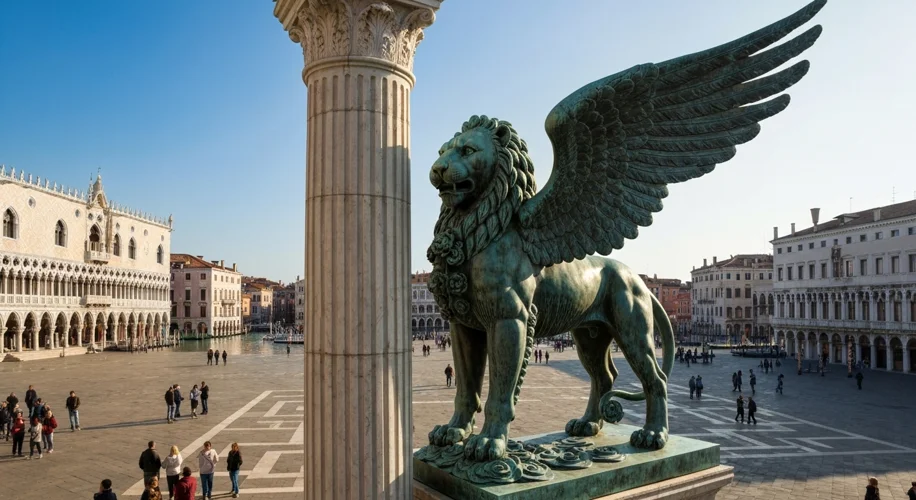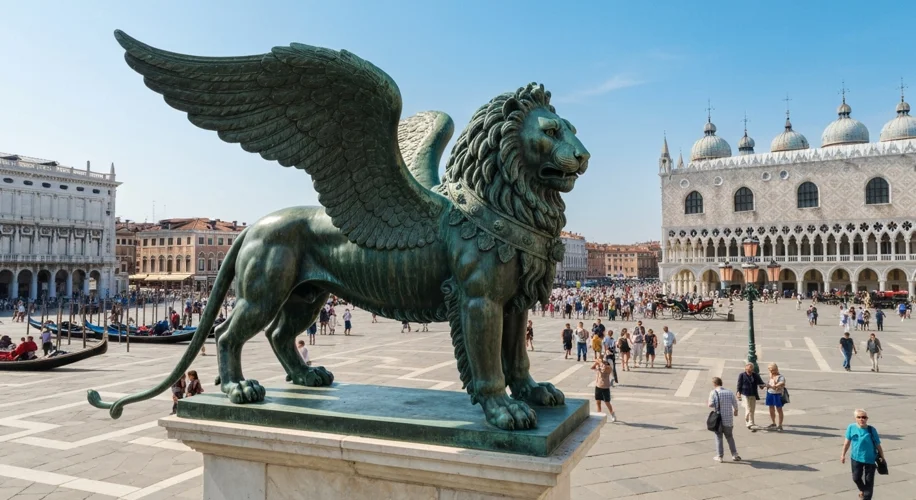In the heart of Venice, a city synonymous with romance, art, and maritime power, stands a colossal winged lion, its gaze fixed eternally upon the Piazza San Marco. This iconic symbol, the Lion of Saint Mark, is deeply interwoven with the identity of La Serenissima. But what if the origins of this majestic creature, often attributed to Venetian artistry, stretch further back and further east than conventionally believed – perhaps even to the workshops of ancient China?
For centuries, the winged lion has been the proud emblem of Venice, a testament to its formidable trade empire and its devotion to Saint Mark the Evangelist, whose relics were brought to the city in the 9th century. The commonly accepted narrative places the creation of the most famous winged lion, the one that presides over the column in St. Mark’s Square, sometime between the 12th and 14th centuries, a product of medieval European craftsmanship. However, a provocative theory, whispered among scholars and collectors, suggests a more ancient and exotic provenance: China.

The genesis of this unconventional idea lies in the striking similarities between Venice’s Winged Lion and certain bronze sculptures found in China, particularly those from the Han Dynasty (206 BCE – 220 CE).
Consider the craftsmanship. The Venetian Lion, though weathered by time and the salty Adriatic air, displays a certain muscularity and a powerful, almost fierce, expression that resonates with ancient Chinese guardian lions, or ‘fu dogs.’ These canine-like creatures, often depicted in pairs, were traditionally placed before imperial palaces, tombs, and temples to ward off evil spirits. They are characterized by their robust forms, elaborate manes, and often a regal, watchful demeanor.
Specifically, some researchers point to the stylistic parallels in the treatment of the wings and the musculature of the body. While European lions of the medieval period often leaned towards more stylized or heraldic representations, the Venetian Lion possesses a primal energy and anatomical detail that, proponents of the theory argue, is more akin to the naturalistic yet powerful depictions found in Han Dynasty bronzes. The very idea of a winged lion as a powerful guardian also has deep roots in Chinese mythology, where creatures like the qilin, a celestial beast often depicted with scales and sometimes wings, served protective roles.
What historical context could possibly bridge the vast geographical and cultural chasm between Venice and Han China? The Silk Road. For centuries, this legendary network of trade routes connected the East and West, facilitating not only the exchange of goods like silk, spices, and precious metals but also the transmission of ideas, technologies, and artistic styles. Venice, a maritime superpower, was a crucial terminus of these trade routes, a place where goods from the Orient met European markets.
It’s conceivable, therefore, that an ancient Chinese bronze artifact, perhaps a sacred object or a tribute from a distant land, could have found its way to Venice. It might have been admired for its artistry and symbolism, and later, perhaps repurposed or used as inspiration for a new Venetian monument. The ancient world was not as disconnected as we sometimes imagine; the movement of luxury goods and artistic influences across vast distances was a hallmark of the era.
Of course, this theory challenges established art historical narratives. Conventional wisdom attributes the iconic Venetian symbol to the artistic traditions of Byzantium and the broader Mediterranean world. Art historians emphasize the lion’s connection to St. Mark and the symbolic representation of Christ’s attributes – his majesty and resurrection – as envisioned within a Western Christian framework.
The debate hinges on detailed stylistic analysis, the provenance of surviving artifacts, and the interpretation of historical trade records. Skeptics argue that the similarities, while noted, are superficial or can be explained by convergent evolution in artistic motifs – the universal human tendency to depict powerful creatures in symbolic ways. They might point out that winged lions, in various forms, do appear in other ancient cultures, such as Assyrian and Persian art, which had more direct contact with the classical Greek world that influenced early European art.
However, the proponents of the Chinese origin theory maintain that the specific rendering of the Venetian Lion’s form, particularly its dynamic pose and the detailed rendering of its musculature and mane, aligns more closely with Han Dynasty bronzework than with other ancient traditions. They suggest that perhaps the original artifact was damaged or altered over time, obscuring some of its original Chinese characteristics, but the fundamental artistic spirit, they argue, remains distinctly Eastern.
If the theory holds water, the implications would be profound. It would not only rewrite a chapter of Venetian art history but also underscore the incredible reach and influence of ancient Chinese craftsmanship. It would serve as a tangible reminder of the interconnectedness of the ancient world, showcasing how artistic innovations and sacred symbols could traverse continents and cultures, leaving their indelible mark on iconic landmarks centuries later.
The mystery of Venice’s Winged Lion, therefore, invites us to look beyond the obvious, to question established narratives, and to appreciate the possibility that even the most familiar symbols might harbor secrets stretching back to the dawn of global exchange. It’s a tale that truly echoes the past, inviting further research and perhaps, one day, a definitive answer that could add another layer of wonder to the enchanting city of Venice.

